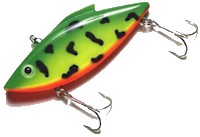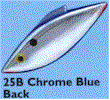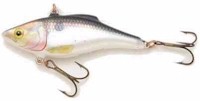Bill Lewis Rat-L-Traps
 Basic
Anatomy. The Bill Lewis Rat-L-Trap is the original
flat-sided, lipless crankbait. It comes with its own built-in
action right out of the box. An angler only has to reel it in
straight and quick, and the lure will do the rest all on its own.
It will automatically RATTLE, VIBRATE and FLASH all by itself,
which is what makes the lure so effective and such a "no
brainier", even for novices. All anyone needs to do is to
retrieve it straight, quick and in close contact to weed tops or
flat bottom, and start getting hits! You also get a great SHAPE
right out of the box. Pick up a shad or bluegill about 3 inches
long. Now pick up every single lure in your tackle box and rank
them as to which lure comes closest to the shape of the natural
bait. I will bet you that your Rat-L-Trap more closely
approximates the bait shape better than anything else you own! Basic
Anatomy. The Bill Lewis Rat-L-Trap is the original
flat-sided, lipless crankbait. It comes with its own built-in
action right out of the box. An angler only has to reel it in
straight and quick, and the lure will do the rest all on its own.
It will automatically RATTLE, VIBRATE and FLASH all by itself,
which is what makes the lure so effective and such a "no
brainier", even for novices. All anyone needs to do is to
retrieve it straight, quick and in close contact to weed tops or
flat bottom, and start getting hits! You also get a great SHAPE
right out of the box. Pick up a shad or bluegill about 3 inches
long. Now pick up every single lure in your tackle box and rank
them as to which lure comes closest to the shape of the natural
bait. I will bet you that your Rat-L-Trap more closely
approximates the bait shape better than anything else you own!
Toss the Salad. The best
application for the Rat-L-Trap is to retrieve it quickly in close
contact with the tops of thick underwater grass beds. As an
angler, you really won't be able to predict where the bass will
be in such thick weed beds. From above the surface, it just looks
like a broad expanse of green down there. But you will know you
are in the right places when YOU SPEND THE ENTIRE DAY REMOVING
SALAD FROM THE TREBLE HOOKS.
Underneath it all, however, bass will be positioned along the
unseen bottom contours and they will be using open cavernous
spaces beneath the weed mats to hunt for prey. From down below,
the bass will clearly hear the loud rattling sound of your
Rat-L-Trap overhead, and they will come barreling out of the
grass beds rather unpredictably to bust the Rat-L-Trap. It is
pretty exciting stuff!
Different Weights and Sizes.
Rat-L-Traps come in six sizes ranging from 1/8 oz. to 1 1/2 oz.
You need to use the right weight Rat-L-Trap to match the depth of
water you have above the weed tops, and retrieve it back quickly
at a speed you feel causes the loudest rattle and the heaviest
vibration in your rod tip. Here are the recommended weights to
use over underwater grass beds. If there is 1-2 feet of water
over the grass, use the 1/4 oz. Mini-Trap, keep the rod tip up,
and burn the lure back. If there is 3-4 feet of water over the
grass, use the 1/2 oz Original Rat-L-Trap to keep it down just
over the grass. If there is 5-6 feet of water over the grass, use
the weighty 3/4 oz. Mag-Trap to keep it down that deep. To go a
few feet deeper, there is now a new, larger 1 oz. Magnum Force
Rat-L-Trap.
Shallow Flats. Another great
application for a Trap is on wind-blown flats. You want the wind
coming right in directly at the shoreline. Ten to fifteen knots
with extra gusts is about right. The windier the better. Pick the
right weight of Trap to keep it just above the flats bottom
(weights and depths were mentioned above for keeping it over the
weed tops) Trust me, you want to keep the Trap just above the
flats bottom for best results. You don't want to be retrieving it
high up in the water column. However, if you start actually
bumping bottom, instantly raise your rod tip higher and reel
faster. Bass and bait can be found anywhere on the broad expanses
of these wind-swept flats. As an angler, you really won't be able
to predict where the bass will be on such broad flats. And once
again, the loud rattling noise will call them in to you from a
distance like no other lure can, and once sighted, the quick
retrieve, heavy vibration, flash and shape of the bottom-hugging
lure will trigger aggressive strikes from active
bass.
Bare Banks. Traps are also good to
use on bare banks that break, either quickly or gradually, into
deeper water. It is important to keep the boat far back from the
first break to deep water. Do not bring the boat over that first
break. Respect that natural boundary and you will keep shallow
bank fish unalarmed. They will feel protected as long as you do
not try to occupy the shallow space with them. They will take
flight if your boat crosses over the berm into the shallows. It
is a natural safety barrier that you shouldn't cross. So keep
back and toss that Trap up a few feet onto the bank, rattling it
all around but good while still on the land, then hop it into the
water with a splash, flap it around where it lays on the bottom
for a few seconds, and then burn it back away from shore as fast
as you can. The important part here is to give it enough time
(10-20 seconds) scratching and kicking around on shore to attract
the fish over to it.
Rocks, Wood. I can't recommend
that you use Rat-L-Traps in stickups, stumps or other rock or
wood cover. They will get snagged pretty easily in wood or rocks,
so I wouldn't try to use them directly in this kind of cover. Of
course, the Rat-L-Trap is a flexible lure, and you can cast them
NEXT TO wood or rock cover if you believe fish are taking feeding
stations right on the outer edges of the cover and will come out
of it to locate the source of the rattling sound. But there are
equivalent lures such as spinnerbaits that are better lures to
use in and around cover than Traps. Let's face it, when bass are
on point on the outer fringes of cover, you know where they are,
and you really don't need something that they can hear rattling
from 100 feet away. Now if they are stalking prey in dark tunnels
and walled-in narrow trails along the very bottom under thick
weed beds, rattles will draw them to you! But alongside cover, a
loud rattling bait is usually not necessary, and prone to snag. I
would rather opt for spinnerbaits which exhibit some of the same
attracting qualities as Traps - quickness, vibration, and flash -
but spinnerbaits are more natural and unalarming, and you can
purposely bounce one into a stump or thick limb, kill it, and
have a good chance not to get snagged. And you can't do that with
a Rat-L-Trap!
 Colors.
Traps come in an incredible array of about 150 different color
patterns. Why? Because color does matter to the fish at times.
Certain unique colors of Rat-L-Traps have even become wildly
successful on certain bodies of water. Day in and day out though,
I am a strong proponent of metallic flash in Traps. That's what
you get out of the box with a Trap - shape, rattle, vibration and
FLASH. To me, flash is a big factor with Traps just as flash is a
factor with spinnerbaits. Colors.
Traps come in an incredible array of about 150 different color
patterns. Why? Because color does matter to the fish at times.
Certain unique colors of Rat-L-Traps have even become wildly
successful on certain bodies of water. Day in and day out though,
I am a strong proponent of metallic flash in Traps. That's what
you get out of the box with a Trap - shape, rattle, vibration and
FLASH. To me, flash is a big factor with Traps just as flash is a
factor with spinnerbaits.  Obviously,
you have two primary choices, gold and chrome flash. For
starters, try a black back on the gold flash (143) and a blue
back on the chrome flash (25B). In clear water, try a non-flash
color such as Smokin' Joe (05) which has a blackened face and
back with a smokey kind of neutral-colored body. There are also
many panfish, baitfish and crayfish patterns to choose from, plus
a bunch of gaudy chartreuse and fire tiger patterns. However, if
you are just starting out with Traps, please get experience with
the basic chrome, gold and Smokin' Joe first. Obviously,
you have two primary choices, gold and chrome flash. For
starters, try a black back on the gold flash (143) and a blue
back on the chrome flash (25B). In clear water, try a non-flash
color such as Smokin' Joe (05) which has a blackened face and
back with a smokey kind of neutral-colored body. There are also
many panfish, baitfish and crayfish patterns to choose from, plus
a bunch of gaudy chartreuse and fire tiger patterns. However, if
you are just starting out with Traps, please get experience with
the basic chrome, gold and Smokin' Joe first.
Sunfish Imitation. Because of its
body shape and tight wiggle, a Rat-L-Trap imitates a sunfish
well. The illusion is heightened by using color patterns to match
sunfish. Where legal, drag Rat-L-Traps through bass beds to
imitate marauding sunfish. You WILL get smashed! A few weeks
later, find a very shallow sunfish spawning flat, and burn this
bait right along the outside lip where the flat drops off a foot
or two. Bounce it into any wood or rock along the way. If you
crank it hard, the hard head will hit the cover, not the hooks.
Throughout the remainder of the summer, this color is best used
in clear water on sunny days. Throw it anywhere there are bug
hatches and bluegills feeding on them...bass will always be near
to feeding sunnies...lurking in the grass edges or just beyond
the drop-off edges. In fact, bass are members of the sunfish
family, and they desire the exact same environmental conditions
as other sunfish. So, even if you see schools of sunfish just
sitting idly in certain areas, you can rest assured that bass are
in the same areas doing the same things. If you spot these
sunnies, throw a sunfish-colored Rat-L-Trap to the closest nearby
cover. Bang the Trap off the spot to get a reaction strike. I
always use them a bit further out away from the heavy cover. On
the fringe edge of emergent cover or over the top of submerged
cover. Remember, you can bump the outside of hard cover and
bounce over it, but if you go all INTO cover with a Rat-L-Trap,
it's most likely to get snagged.
Rods. Ideally, you need a
soft-tipped rod both to allow you to feel the lure working
properly and to allow you to set the hook more slowly and to
fight the fish more gently. The soft rod tip will give you
feedback so you can feel the throbbing vibration of the bait in
the tip, and therefore calibrate the reel retrieve speed to get
the heaviest vibration and loudest rattle possible. Again,
the qualities of a good Rat-L-Trap rod also apply to a good
spinnerbait rod. In both cases, you use feel of the lure's
vibration in the rod tip to hone in on the best reel retrieve
speed.
Line. Over open flats, I always
keep a Trap moving or else it will sink and get snagged. A mono
line floats better, keeping the Rat-L-Trap up off bottom. Mono
should range from 10-12 for the 1/4 oz Trap, 12-15 for the 1/2
oz., and up to 20 for the 3/4 and 1 oz. Traps. Whenever in weeds,
a braided line cuts grass like a weed-whacker filament! You can
use micro-braids to cut through grass and viciously rip the
Rat-L-Trap off weed stalks as you burn through weed beds.
Hesitate after you rip it - and get slammed!
 Hooks.
The body shape and rattles inside a lipless crankbait
makes it one of the easiest lures for a jumping fish to throw
loose. So fight fish gingerly on a loose drag and do whatever
else you need to avoid jumping. Many people replace the hooks on
lipless crankbaits with the turned-in Mustad Triple Grip trebles,
making it harder for bass to shake them loose. Hooks.
The body shape and rattles inside a lipless crankbait
makes it one of the easiest lures for a jumping fish to throw
loose. So fight fish gingerly on a loose drag and do whatever
else you need to avoid jumping. Many people replace the hooks on
lipless crankbaits with the turned-in Mustad Triple Grip trebles,
making it harder for bass to shake them loose.
 Other
Lipless Crankbaits. Everything that we've said about
Rat-L-Traps applies equally to other lipless crankbaits. Both the
Excalibur Super Spot and the Rapala Rattlin' Rap (shown at right)
are popular alternative choices. Other
Lipless Crankbaits. Everything that we've said about
Rat-L-Traps applies equally to other lipless crankbaits. Both the
Excalibur Super Spot and the Rapala Rattlin' Rap (shown at right)
are popular alternative choices.
Good luck to you. Trap a few for me! |
